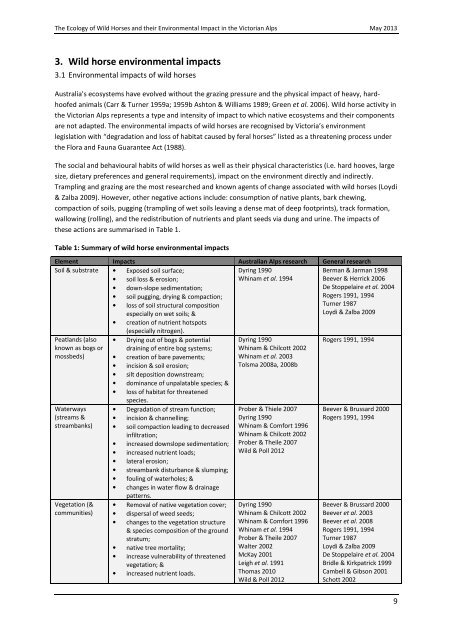The Ecology of Wild Horses and their Environmental ... - Parks Victoria
The Ecology of Wild Horses and their Environmental ... - Parks Victoria
The Ecology of Wild Horses and their Environmental ... - Parks Victoria
You also want an ePaper? Increase the reach of your titles
YUMPU automatically turns print PDFs into web optimized ePapers that Google loves.
<strong>The</strong> <strong>Ecology</strong> <strong>of</strong> <strong>Wild</strong> <strong>Horses</strong> <strong>and</strong> <strong>their</strong> <strong>Environmental</strong> Impact in the <strong>Victoria</strong>n Alps May 20133. <strong>Wild</strong> horse environmental impacts3.1 <strong>Environmental</strong> impacts <strong>of</strong> wild horsesAustralia's ecosystems have evolved without the grazing pressure <strong>and</strong> the physical impact <strong>of</strong> heavy, hardho<strong>of</strong>edanimals (Carr & Turner 1959a; 1959b Ashton & Williams 1989; Green et al. 2006). <strong>Wild</strong> horse activity inthe <strong>Victoria</strong>n Alps represents a type <strong>and</strong> intensity <strong>of</strong> impact to which native ecosystems <strong>and</strong> <strong>their</strong> componentsare not adapted. <strong>The</strong> environmental impacts <strong>of</strong> wild horses are recognised by <strong>Victoria</strong>’s environmentlegislation with “degradation <strong>and</strong> loss <strong>of</strong> habitat caused by feral horses” listed as a threatening process underthe Flora <strong>and</strong> Fauna Guarantee Act (1988).<strong>The</strong> social <strong>and</strong> behavioural habits <strong>of</strong> wild horses as well as <strong>their</strong> physical characteristics (i.e. hard hooves, largesize, dietary preferences <strong>and</strong> general requirements), impact on the environment directly <strong>and</strong> indirectly.Trampling <strong>and</strong> grazing are the most researched <strong>and</strong> known agents <strong>of</strong> change associated with wild horses (Loydi& Zalba 2009). However, other negative actions include: consumption <strong>of</strong> native plants, bark chewing,compaction <strong>of</strong> soils, pugging (trampling <strong>of</strong> wet soils leaving a dense mat <strong>of</strong> deep footprints), track formation,wallowing (rolling), <strong>and</strong> the redistribution <strong>of</strong> nutrients <strong>and</strong> plant seeds via dung <strong>and</strong> urine. <strong>The</strong> impacts <strong>of</strong>these actions are summarised in Table 1.Table 1: Summary <strong>of</strong> wild horse environmental impactsElement Impacts Australian Alps research General researchSoil & substrate • Exposed soil surface;Dyring 1990Berman & Jarman 1998• soil loss & erosion;Whinam et al. 1994 Beever & Herrick 2006• down-slope sedimentation;De Stoppelaire et al. 2004• soil pugging, drying & compaction;Rogers 1991, 1994• loss <strong>of</strong> soil structural compositionTurner 1987especially on wet soils; &Loydi & Zalba 2009• creation <strong>of</strong> nutrient hotspots(especially nitrogen).Peatl<strong>and</strong>s (alsoknown as bogs ormossbeds)Waterways(streams &streambanks)Vegetation (&communities)• Drying out <strong>of</strong> bogs & potentialdraining <strong>of</strong> entire bog systems;• creation <strong>of</strong> bare pavements;• incision & soil erosion;• silt deposition downstream;• dominance <strong>of</strong> unpalatable species; &• loss <strong>of</strong> habitat for threatenedspecies.• Degradation <strong>of</strong> stream function;• incision & channelling;• soil compaction leading to decreasedinfiltration;• increased downslope sedimentation;• increased nutrient loads;• lateral erosion;• streambank disturbance & slumping;• fouling <strong>of</strong> waterholes; &• changes in water flow & drainagepatterns.• Removal <strong>of</strong> native vegetation cover;• dispersal <strong>of</strong> weed seeds;• changes to the vegetation structure& species composition <strong>of</strong> the groundstratum;• native tree mortality;• increase vulnerability <strong>of</strong> threatenedvegetation; &• increased nutrient loads.Dyring 1990Whinam & Chilcott 2002Whinam et al. 2003Tolsma 2008a, 2008bProber & Thiele 2007Dyring 1990Whinam & Comfort 1996Whinam & Chilcott 2002Prober & <strong>The</strong>ile 2007<strong>Wild</strong> & Poll 2012Dyring 1990Whinam & Chilcott 2002Whinam & Comfort 1996Whinam et al. 1994Prober & <strong>The</strong>ile 2007Walter 2002McKay 2001Leigh et al. 1991Thomas 2010<strong>Wild</strong> & Poll 2012Rogers 1991, 1994Beever & Brussard 2000Rogers 1991, 1994Beever & Brussard 2000Beever et al. 2003Beever et al. 2008Rogers 1991, 1994Turner 1987Loydi & Zalba 2009De Stoppelaire et al. 2004Bridle & Kirkpatrick 1999Cambell & Gibson 2001Schott 20029
















